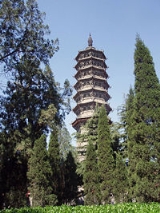
Pagoda of Bailin Temple
Encyclopedia

Zhao County
Zhao County , a historic town called Zhaozhou in the past, is located in Hebei 40 km southeast of the provincial capital Shijiazhuang, and 280 km south of Beijing. Its total land area is 675 km² and total population is around 550,000...
, Hebei
Hebei
' is a province of the People's Republic of China in the North China region. Its one-character abbreviation is "" , named after Ji Province, a Han Dynasty province that included what is now southern Hebei...
province, China
China
Chinese civilization may refer to:* China for more general discussion of the country.* Chinese culture* Greater China, the transnational community of ethnic Chinese.* History of China* Sinosphere, the area historically affected by Chinese culture...
is an octagonal-based brick Chinese pagoda
Chinese pagoda
Chinese Pagodas are a traditional part of Chinese architecture. In addition to religious use, since ancient times Chinese pagodas have been praised for the spectacular views which they offer, and many famous poems in Chinese history attest to the joy of scaling pagodas.-History:The pagoda is...
built in 1330 during the reign of Emperor Wenzong, ruler of the Mongol-led Yuan Dynasty
Yuan Dynasty
The Yuan Dynasty , or Great Yuan Empire was a ruling dynasty founded by the Mongol leader Kublai Khan, who ruled most of present-day China, all of modern Mongolia and its surrounding areas, lasting officially from 1271 to 1368. It is considered both as a division of the Mongol Empire and as an...
(1271–1368).
Features
This seven story pagoda stands at a height of about 40 m (131 ft), built on a stone foundation. The lower section of the pagoda is a brick sumeruSumeru
Sumeru or Sineru is the name of the central world-mountain in Buddhist cosmology. Etymologically, the proper name of the mountain is Meru , to which is added the approbatory prefix su-, resulting in the meaning "excellent Meru" or "wonderful Meru".The concept of Sumeru is closely related to the...
pedestal, which features two rows of intricate carvings that include artwork of musicians, celestial guardians, animals, and peonies. The first story of this solid brick pagoda features a facade of doors and windows, as well as columns, rafters, and brackets
Dougong
Dougong is a unique structural element of interlocking wooden brackets, one of the most important elements in traditional Chinese architecture....
. Above this are seven tiers of eaves. The design style of this pagoda follows the tradition of the Liao Dynasty
Liao Dynasty
The Liao Dynasty , also known as the Khitan Empire was an empire in East Asia that ruled over the regions of Manchuria, Mongolia, and parts of northern China proper between 9071125...
and Jin Dynasty, which were Khitan
Khitan people
thumb|250px|Khitans [[Eagle hunting|using eagles to hunt]], painted during the Chinese [[Song Dynasty]].The Khitan people , or Khitai, Kitan, or Kidan, were a nomadic Mongolic people, originally located at Mongolia and Manchuria from the 4th century...
and Jurchen dynasties that ruled northern China before Kublai Khan
Kublai Khan
Kublai Khan , born Kublai and also known by the temple name Shizu , was the fifth Great Khan of the Mongol Empire from 1260 to 1294 and the founder of the Yuan Dynasty in China...
established the Yuan.

